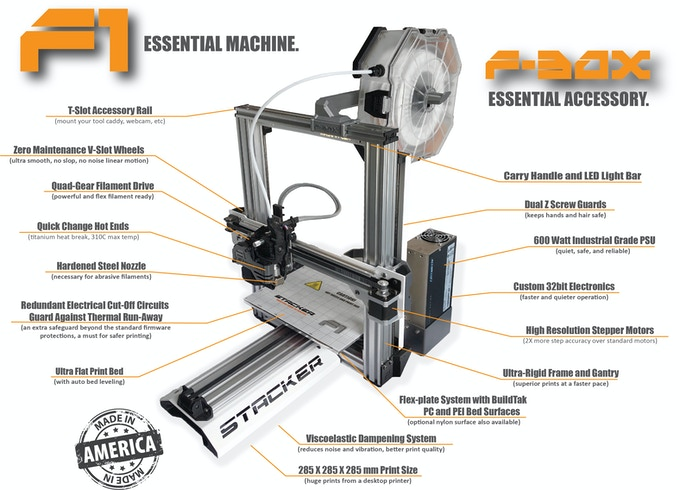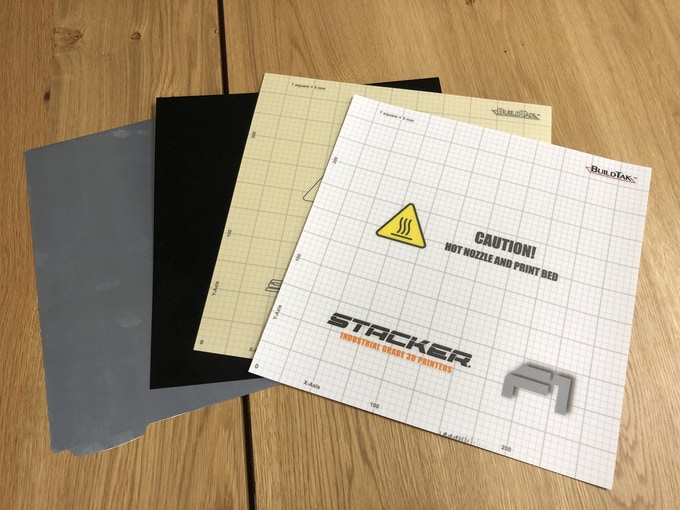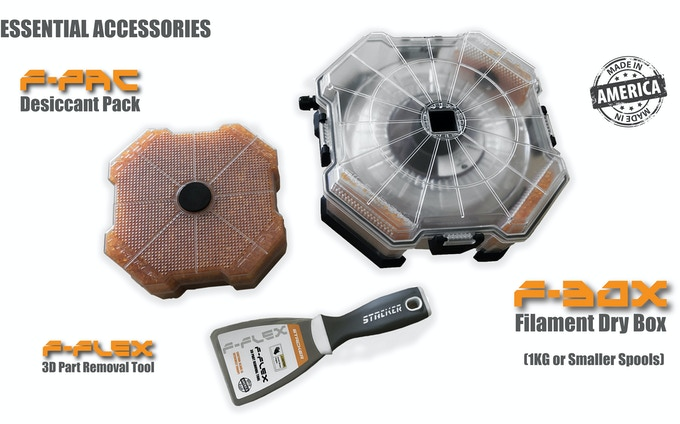3D printer Kickstarter campaigns don’t all get it right, but when it comes to crowdfunding, industrial-grade 3D printer provider STACKER seems to know what it’s doing. The Minnesota-based company just closed a very successful Kickstarter campaign for the new STACKER F1 3D printer, which it’s calling “The Essential Office Machine,” and a new line of F-Series accessories. The initial $100,000 goal was met within the first 24 hours of the campaign opening, and by the end, more than 700 backers pledged $290,010 to bring the STACKER F1 to life.
“We did our best to infuse the F1 with best-in-class safety, print quality, and reliability. It’s also the most affordable industrial grade 3D printer we have ever built,” the Kickstarter campaign states. “We also did our best to design much needed accessories that work with nearly all 3D printers on the market today.”
During the ongoing COVID-19 pandemic, we’ve seen global supply chains be completely overwhelmed, and 3D printing has stepped up numerous times to help save the day by fabricating everything from ventilator parts and face shields to nasal swabs. This situation clearly shows the importance of local, on-demand manufacturing—who knows when the next pandemic might occur? This is where the STACKER F1 comes in.
“Imagine if every small business, college, hospital, or fortune 500 company had just one 3D printer? Or five of them? Just imagine the impact this would have. It’s time for all industries to get involved with 3D printing. It’s time to establish your own manufacturing plant. Your own print farm. Your own creative space. It’s time for you to get the essential office machine.”
STACKER created the “high-performance” F1, with its 285 x 285 x 285 mm build volume, so it could be used in schools, research labs, offices, printer farms, makerspaces, hospitals, businesses, and at home. The company gives three reasons why the printer is a great choice: safety, print quality, and reliability.
The F1 has several safety features, one of which is advanced thermal runway protection, which provides redundant electronic power cut-off circuits that are independent from firmware or software. So crashed firmware or a bad transistor won’t keep the circuit from doing what it’s supposed to do, and two temperature sensors add an additional layer of security: if there’s a temperature reading higher than 325°, power to the hot end is cut automatically.
Additional safety features include:
- temperature sensors mounted in metal cartridges for secure attachment
- special hot end heat break and heat sink
- hot end mount use UL-approved flame retardant materials
- insulated, guarded heater block to reduce severe burning
- special Z axis rod guards to protect fingers and hair from getting pinched
In terms of print quality, the compact STACKER F1 has a strong, rigid frame and gantry system, and a chassis dampening system, which combines vibration isolation, shock absorption, and vibration damping characteristics. Additionally, specialized filament drive gears and gear reduction on the filament drive were designed for “increased power and precision,” and the drive gears are made of hardened steel; instead of plastic, the reduction gears are stainless steel. STACKER also says that the F1 can deliver accurate parts, with sharp corners and no extrusion, that fit together.
“The F1’s firmware incorporates a hot end pressure balancing feature that reduces the extruder movement precisely as needed before the hot end reaches any portion of the part that slows down. This allows the pressure inside the hot end to release and do the extruding instead of the filament drive.”
Finally, reliability, which STACKER believes “starts with engineering and ends with the selection of premium components and high quality manufacturing.” The F1’s hot end, and high speed Vanadium nozzles, can be quickly and easily changed in case of jams, and the printer is run by a premium 600 watt Artesyn power supply. It uses power factor correction (PFC), which is not only required by international regulations but also “ensures that input voltage and current waveforms are as sinusoidal as possible.”
STACKER worked with BuildTAK to make custom PEI and PC print bed sheets and a flex plate system for the F1, and the printer comes with a single steel flex plate and one each of the PEI and PC sheets.
Additional features of the STACKER F1 include:
- T-slot accessory rail for mounting webcams, filament spool holders, etc.
- ultra smooth V-slot wheels
- quad-gear filament drive
- auto bed leveling
- ultra quiet motor drivers and high resolution stepper motors
- carry handle and customizable front logo plate
- wire-free controller box to reduce potential for shorted wires
- license for Simplify3D slicing software
- Repetier server software
- F-BOX compatible
The F-BOX sounds like a great performance upgrade from STACKER that’s “guaranteed to make your prints stronger and better looking.” The F-BOX keeps your filament dry, which definitely makes prints stronger and improves surface finish, and can be mounted on any filament printer; the company has designed custom brackets for many popular systems, and will make the CAD files and STL modes available on its website.
STACKER also came out with two other accessories: the F-Flex Part Removal Tool, which has a very sharp, thin blade with rounded edges so it won’t dig into the build plate, and the F-PAC High Performance Desiccant Pack, which holds approximately 2.5 lbs of high-performance desiccant to keep filament dry.
If you didn’t participate in the STACKER F1 Kickstarter campaign but are interested in owning it, you can purchase the printer for $2,995 starting in December.
(Images courtesy of STACKER)
Subscribe to Our Email Newsletter
Stay up-to-date on all the latest news from the 3D printing industry and receive information and offers from third party vendors.
You May Also Like
Insights from Cantor Fitzgerald on AM’s Q1 2024 Landscape
A recent survey by Cantor Fitzgerald sheds light on the persistent challenges within the additive manufacturing (AM) industry in the first quarter of 2024. Based on responses from 38 industry...
3D Printing Financials: voxeljet’s NASDAQ Exit and Final US Stock Earnings Report
In an anticipated move, voxeljet has transitioned from the Nasdaq to the Over-The-Counter (OTC) market amid the challenges reflected in its stock performance and the broader financial landscape. Furthermore, the...
Seurat CFO Di Paola Shares Insights on Defying Industry Trends in 3D Printing
In an industry where 3D printing public companies are grappling with troubled earnings and workforce reductions, Seurat is defying market trends by increasing its workforce sevenfold, growing from 20 to...
Printing Money Episode 16: Q4 Earnings Analysis with Troy Jensen, Cantor Fitzgerald
The Q4 earnings season is a wrap, and to put a bow on it here is Episode 16 of Printing Money, with Troy Jensen (Cantor Fitzgerald) returning to join Danny...






































